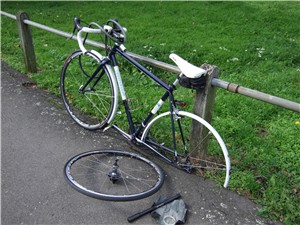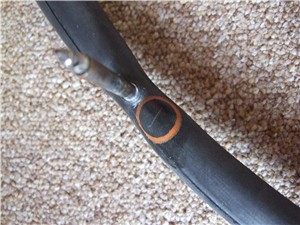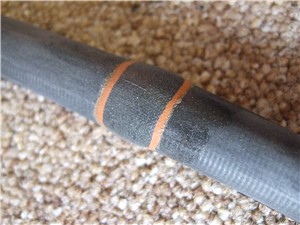


Punctures announce themselves in many ways: recently I have had the “sudden deflation with no warning”, the “almost-instant deflation preceded by a bump to suggest that something harmful to pneumatic tyres has been run over” and, most recently, the “imperceptible loss of pressure that only makes itself known with a rear wheel slide going round a corner”.
Going back along the road to find the cause of the almost-instant deflation preceded by a bump to suggest that something harmful to pneumatic tyres has been run over proved a waste of time, nothing obviously sharp-edged being found to explain the “snake bite” pair of holes that marks a pinch flat. Its cause remains a complete mystery.
Riding in to work one morning, I touched a large stone with my back tyre and within a nanosecond was riding on the rim. The sudden deflation with no warning was, of course, the result of another pinch flat. The tube was beyond hope and I binned it.
The reason for the flat that shortly followed, which was of the imperceptible loss of pressure that only makes itself known with a rear wheel slide going round a corner type, could be quickly identified as a miniscule flint just long enough to nick but not actually perforate the inner tube, resulting in a classic “slow” puncture. The big decision when faced with a slow puncture is whether to fit a new tube of re-inflate the existing one in the hope that it will stay up long enough to get you to your destination. It never does.
With this fact in mind. I went for my second spare only to notice that it was rolled up in a spiral rather than in the palmier pattern I use for good tubes. No probs; I have a repair outfit and used it. Once at RCUK HQ I initially decided to risk riding home with no good spare and one holed tube. However, on return from lunch, Dave “Shiny Boy” Arthur delightedly pointed out that my back tyre was again flat, which meant I would have to repair at least one tube to get home.
I got out the offending inner tube, which clearly had a second, even slower slow puncture which I could only locate by holding the tube in a water-filled wash basin. The hole, if you could call it that, was right by the valve. Normally I would not patch a tube so close to the valve, but this was turning into something of an emergency.
Sensing that if, on this particular day, I risked the ride home without a good spare I’d inevitably get another flat, I decided to repair the holed tube found earlier rolled up in a spiral in my saddle pack. This was, of course, the pinch-flatted tube holed on the occasion of the the almost-instant deflation preceded by a bump to suggest that something harmful to pneumatic tyres has been run over and I had obviously failed to swap it for a good one when I got home.
The “snake bite” pinch flat is another mode of puncture I don’t usually repair, the distance between the two holes too great for a small Tip-Top patch to cover reliably. In desperation I riffled through the selction of patches in my outfit and found an oblong one big enough to cover both holes with room to spare. So, there it is, still sitting in my saddle pack, rolled up palmier-style and ready to roll, whatever type of flat should strike next – assuming the patch really is big enough to cover both holes with room to spare. Maybe I’ll swap it for a better one when I get round to it.





